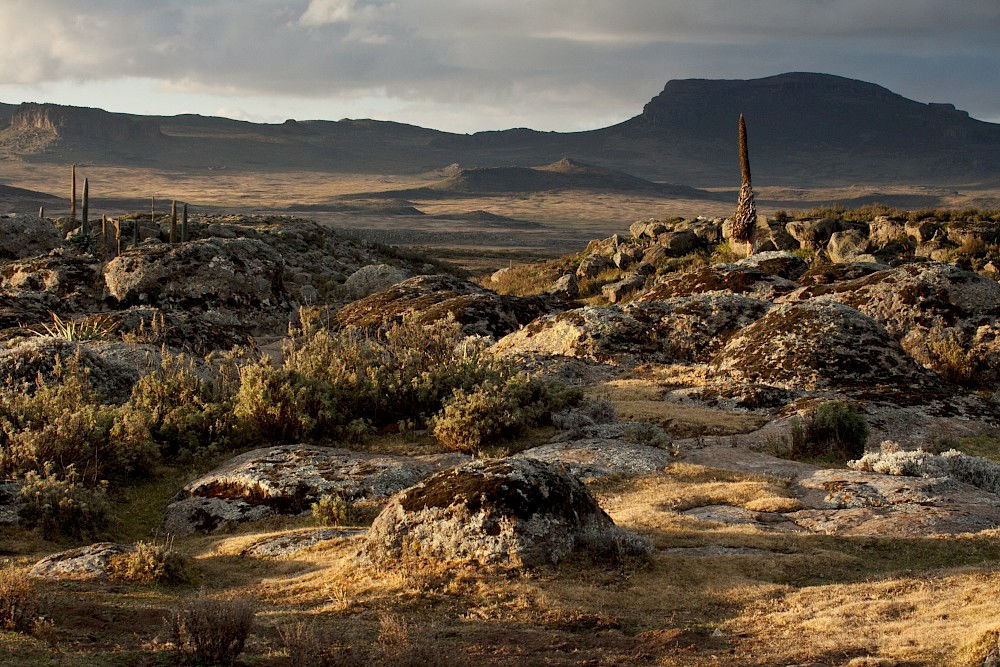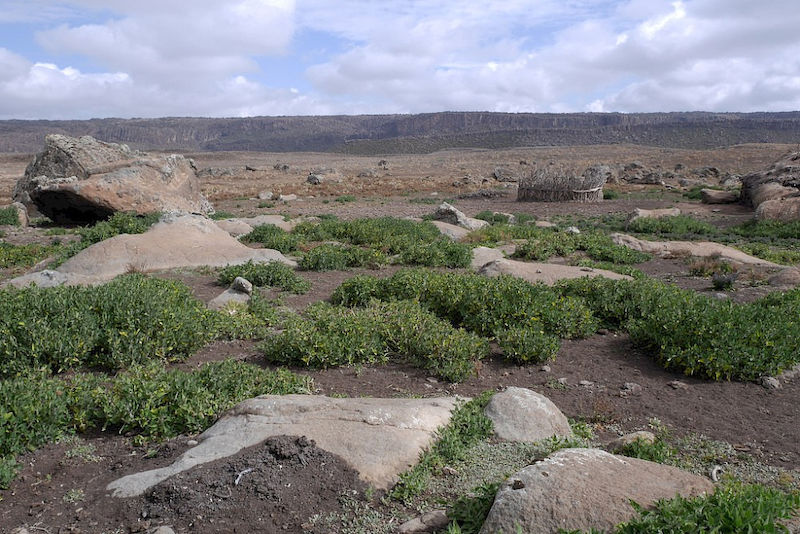Ice age in Ethiopia: refuge in the mountains?

It is not particularly the most human-friendly region in the world: it rains a lot in the Bale Mountains in southern Ethiopia and temperatures can fluctuate drastically. The strip of land is between 3,700 and 4,100 meters above sea level. The air here is thin and its low oxygen content is hard on humans, impairing their metabolism. This means it’s much harder to move in the mountains than in the valley. That is why nature in this region is still relatively untouched. At the same time the region is home to some unique plant and animal species. “Because living conditions are so poor for human beings, it is assumed that the afro-alpine region was settled quite late,” says Bruno Glaser, professor of Soil Biogeochemistry at the University of Halle. As part of the research group “The Mountain Exile Hypothesis”, which is funded by the German Research Foundation and spearheaded by the University of Marburg, Glaser and his colleague Professor Wolfgang Zech from Bayreuth ideally want to prove the opposite. The scientists are working on the project with researchers from Germany, France and Great Britain. Their hypothesis: humans in Africa took refuge on the plateau as early as during the last ice age 16,000 to 10,000 years ago.
During a cold period it is actually colder in the mountains, which is why in the last 500,000 years people in Europe always moved to the warmer valleys. “In Africa the cold and warm periods were not as severe,” Glaser explains, who is very familiar with Ethiopia from earlier research projects on sustainable forest and soil use. The mountain plateaus were not iced over, but the valleys were too dry for humans. So far there has been no conclusive evidence of where they took refuge during this time.
One particular fact backs up the international research group’s hypothesis: “The inhabitants of the Ethiopian highlands have genetically adapted to low amounts of oxygen in the air.” It takes many thousands of years for such a change to occur in a human’s genetic material.
Using the soil as an archive
If there really were human settlements in the mountains there would have to be traces of this – and these traces would still have to be detectable thousands of years later: for example, in the soil or in the plant world. It is precisely these two areas that Glaser and Zech want to examine. “Unlike archaeologists who look for stone artifacts in nature, we use the soil as a source of information,” says Glaser.
Sometimes you can detect where people settled using only the naked eye. “This soil is darker because it contains a lot of soot. It is very fertile soil,” Glaser explains. In order for the work of the soil scientists to be successful, they need natural areas that are as unspoiled as possible. The soil profile shouldn’t be disturbed very much by much later influences. The relatively human-unfriendly region of the Bale Mountains provides these conditions. “The soil has only been changed on the surface during the last centuries and millennia. The chronology has been retained.” Glaser and Zech’s group is therefore planning several expeditions to the Bale Mountains in order to take soil samples at different sites.
Mankind or nature?
The researchers are able to conduct various chemical analyses on the soil samples and draw conclusions. Humans excrete a specific amount of phosphorous per day, for example. Based on the residues in the soil it is possible to calculate how many people once lived in a specific area. “This allows whole areas to be mapped and we can reconstruct how many people lived in an area and at what point in time.” Naturally the scientists are unable to obtain precise information about the person and the day, however the data is sufficient in providing a “feeling of how large and intensive the settlements were”. Astonishingly precise information can be gathered for a period of up to 16,000 years. “By the end we will be able to say, for example, that this area was settled by an average of 1,000 people for around 500 years.”
Glaser explains that the plant world also exhibits many traces of man-made changes. For example, it is striking that the heather Erica only grows in patches on the Sanetti Plateau – there are no large contiguous areas. Because the shrubs react sensitively to fire – which the people back then would have brought to the region if they had been there – this distinctive feature could be an indication that the area had been settled and that humans had changed the local plant world. This pattern of vegetation could just as well be the result of climate change.
In order to understand how climate impacts plants, scientists first need to find out what the prevailing climate conditions were in the mountains 10,000 years ago. Modelling this is the task of the second project headed by Dr Michael Zech, a colleague of Bruno Glaser. In this project the scientists will attempt to understand several weather parameters over the millennia. These include temperature, humidity and amount of precipitation. Once again sedimentary deposition in the soil serves as an archive for their analyses. These are examined using an innovative paleothermometer, based on oxygen and hydrogen isotopes, which was developed by Zech and Glaser in an isotope lab in Halle.
The results of the work in Halle and Bayreuth are incorporated into the higher level project in which further geologists, archaeologists and biologists are working. Ultimately a coherent response should be found to the question of whether humans actually fled to the mountains 16,000 years ago to escape from the cold and dryness. “It would be sensational if we managed this,” says Glaser. But until then, several expeditions to Ethiopia and lab analyses are needed.
Kontakt: Prof. Dr. Bruno Glaser
Bodenbiogeochemie
Tel.: +49 345 55-22532
E-Mail schicken


